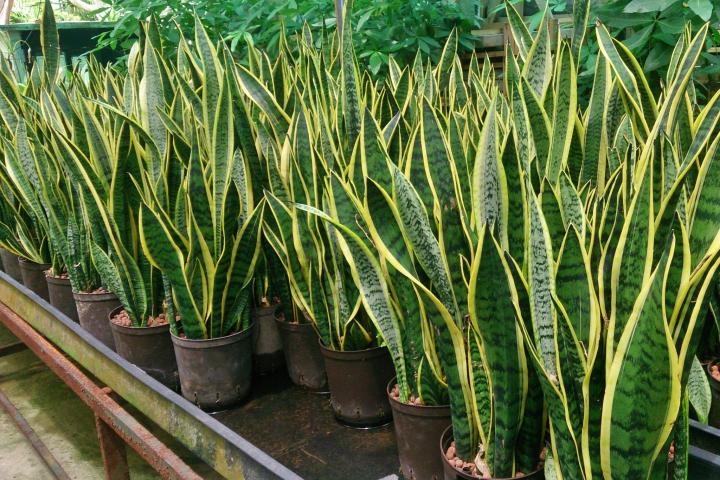
Growing Snake Plants: Watering, Lighting, Propagation, and Pests
The Almanac Garden Planner - Use It Free for 7 Days!
Plan your 2025 garden with our award-winning Garden Planner.
Types
- Dracaena trifasciata (a.k.a. Sansevieria trifasciata) is the most common species of snake plant. It has tall, dark-green leaves with light grayish-green horizontal stripes.
- ‘Bantel’s Sensation’ — Narrow leaves have white vertical stripes and grow to about 3 feet long. This variety can be hard to find.
- D. hahnii:
- ‘Bird’s Nest’ — Short, wide leaves of dark and light green form a tight nest shape like a bromeliad. Leaves only grow 6 to 8 inches long. This variety does need much light to grow well.
- ‘Golden Hahnii’ — Like the standard ‘Bird’s Nest’ but with leaves variegated along the edge in yellow.
- D. cylindrica:
- ‘Cylindrical Snake Plant’ — As its name suggests, this species of snake plant has cylindrical leaves that end in a fierce point.
- ‘Starfish Snake Plant’ — The starfish snake plant has cylindrical leaves that fan out from its base, giving it a starfish-like shape.
- D. masoniana:
- ‘Whale Fin’ — These interesting snake plants have large, wide leaves that resemble the fin of a whale breaching the water’s surface.
ADVERTISEMENT
I bought a snake plant from a cutting that had light green of the sides of the leaf, mine are growing & propagating, but all leaves are only green. Help
Hi Debbie,
When a new snake plant is created from a cutting its unique foliage patterns, such as variegation, mottled leaves, and different colored edge, are usually lost and most plants will end up with single green color. In order to propagate a new plant that looks exactly like the original—with the same leaf coloring—you need to divide the original plant.
Hope this helps!
Very good
All the guides I have found say to plant the draceana at the same depth it was in the old pot. I think it was too deep in the old pot -- another time, too shallow. Please please please please tell us the corm/root should be X inches below the surface. Or the base of the growing leaf should be X inches below or at or above.
55 years ago when my daughter was born, my husbands buddies from college sent me a snake plant. I cannot tell youhaw many people have received "pups" from this plant and it goes on and on. I can also be propagated by cutting a leaf and sticking that in damp vermiculite or even just water and placing in indirect light where it will root and also go on and on if cared for properly.
Snake plants
Please check, the name of this plant was changed to Dracaena Trifasciata.
Please update your article.
Thank you, M
Who Changed the name to Dracaena. It has never been a Dracaena. It is considered a Succulent and a member of the Lilly Family, hence the low watering needs. People make up names. But all my books and research do not say it is a Dracaena. Sansevierias are a native of Africa more particularly, laurentii is native of the N.E. Congo in Africa. "Variegated snake plant" or "Goldband Sansevieria" It can grow to 1/2 to 1-1/2 meters high.
Well I did some more research and according to the The Angiosperm Phylogeny Group, they are using DNA to reidentify plants. ARGGG! "The Genus FKA Sansevieria was reclassified in 2014 by scientists Pei-Luen Lu and Clifford Morden after a phylogenetic analysis of the genera (plural of genus) Dracaena, Sansevieria, They found that Sansevieria is a unique group, but that it is descended from Dracaena." So all you growers out there, change your plant tags! LOL
The variety shown in the photos with the yellow stripes on the sides of the plant are: Sansevieria trifasciata laurentii. I don't know why FA doesn't label their photos of variety, and zones if applicable. Having a Horticulture Degree and I am finding plants in nursery's with less and less information and it is frustrating. I need to know, Zone, Hight, Width, sun and watering, and full variety of plants. Growers aren't supplying this information and it is wrong to assume people know how to plant and were to plant.
My snake pkant grows in a full bucket of water!











